Ziwei Wan
Toward Near-Space Communication Network in the 6G and Beyond Era
May 18, 2025Abstract:Near-space communication network (NS-ComNet), as an indispensable component of sixth-generation (6G) and beyond mobile communication systems and the space-air-ground-sea integrated network (SAGSIN), demonstrates unique advantages in wide-area coverage, long-endurance high-altitude operation, and highly flexible deployment. This paper presents a comprehensive review of NS-ComNet for 6G and beyond era. Specifically, by contrasting satellite, low-altitude unmanned-aerial-vehicle (UAV), and terrestrial communications, we first elucidate the background and motivation for integrating NS-ComNet into 6G network architectures. Subsequently, we review the developmental status of near-space platforms, including high-altitude balloons, solar-powered UAVs, and stratospheric airships, and analyze critical challenges faced by NS-ComNet. To address these challenges, the research focuses on key enabling technologies such as topology design, resource and handover management, multi-objective joint optimization, etc., with particular emphasis on artificial intelligence techniques for NS-ComNet. Finally, envisioning future intelligent collaborative networks that integrate NS-ComNet with satellite-UAV-terrestrial systems, we explore promising directions. This paper aims to provide technical insights and research foundations for the systematic construction of NS-ComNet and its deep deployment in the 6G and beyond era.
MmWave-LoRadar Empowered Vehicular Integrated Sensing and Communication Systems: LoRa Meets FMCW
May 16, 2025Abstract:The integrated sensing and communication (ISAC) technique is regarded as a key component in future vehicular applications. In this paper, we propose an ISAC solution that integrates Long Range (LoRa) modulation with frequency-modulated continuous wave (FMCW) radar in the millimeter-wave (mmWave) band, called mmWave-LoRadar. This design introduces the sensing capabilities to the LoRa communication with a simplified hardware architecture. Particularly, we uncover the dual discontinuity issues in time and phase of the mmWave-LoRadar received signals, rendering conventional signal processing techniques ineffective. As a remedy, we propose a corresponding hardware design and signal processing schemes under the compressed sampling framework. These techniques effectively cope with the dual discontinuity issues and mitigate the demands for high-sampling-rate analog-to-digital converters while achieving good performance. Simulation results demonstrate the superiority of the mmWave-LoRadar ISAC system in vehicular communication and sensing networks.
Pre-Equalization Aided Grant-Free Massive Access in Massive MIMO System
Feb 10, 2025Abstract:The spatial diversity and multiplexing advantages of massive multi-input-multi-output (mMIMO) can significantly improve the capacity of massive non-orthogonal multiple access (NOMA) in machine type communications. However, state-of-the-art grant-free massive NOMA schemes for mMIMO systems require accurate estimation of random access channels to perform activity detection and the following coherent data demodulation, which suffers from excessive pilot overhead and access latency. To address this, we propose a pre-equalization aided grant-free massive access scheme for mMIMO systems, where an iterative detection scheme is conceived. Specifically, the base station (BS) firstly activates one of its antennas (i.e., beacon antenna) to broadcast a beacon signal, which facilitates the user equipment (UEs) to perform downlink channel estimation and pre-equalize the uplink random access signal with respect to the channels associated with the beacon antenna. During the uplink transmission stage, the BS detects UEs' activity and data by using the proposed iterative detection algorithm, which consists of three modules: coarse data detection (DD), data-aided channel estimation (CE), and fine DD. In the proposed algorithm, the joint activity and DD is firstly performed based on the signals received by the beacon antenna. Subsequently, the DD is further refined by iteratively performing data-aided CE module and fine DD module using signals received by all BS antennas. Our simulation results demonstrate that the proposed scheme outperforms state-of-the-art mMIMO-based grant-free massive NOMA schemes with the same access latency.
Near-Space Communications: The Last Piece of 6G Space-Air-Ground-Sea Integrated Network Puzzle
Dec 30, 2023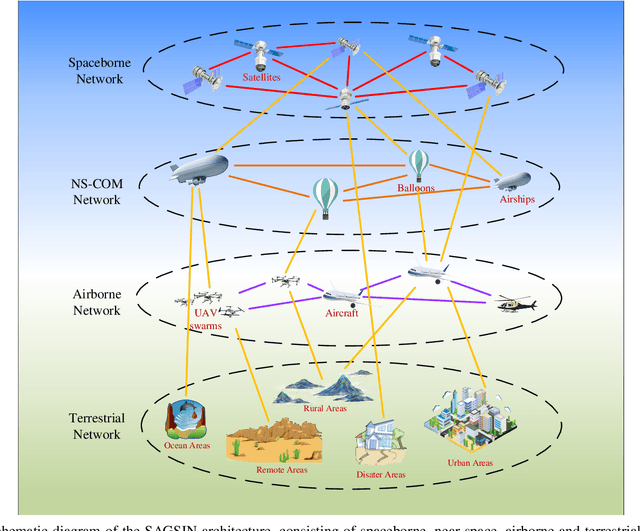
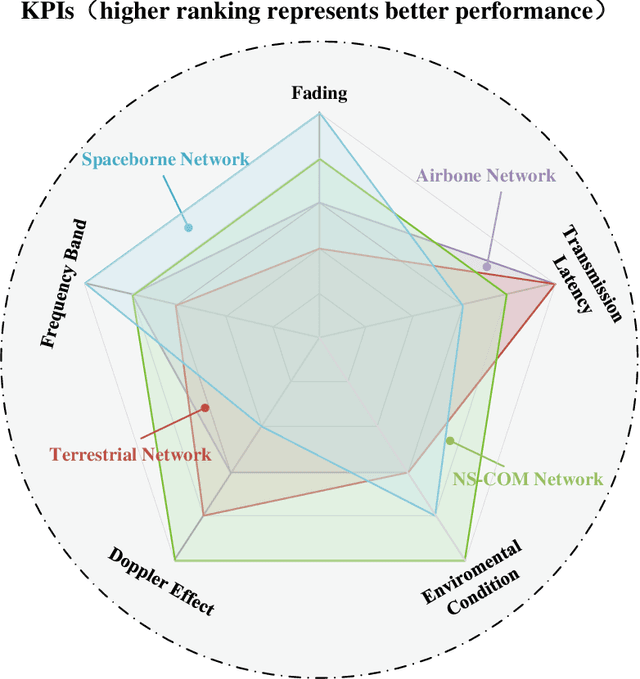
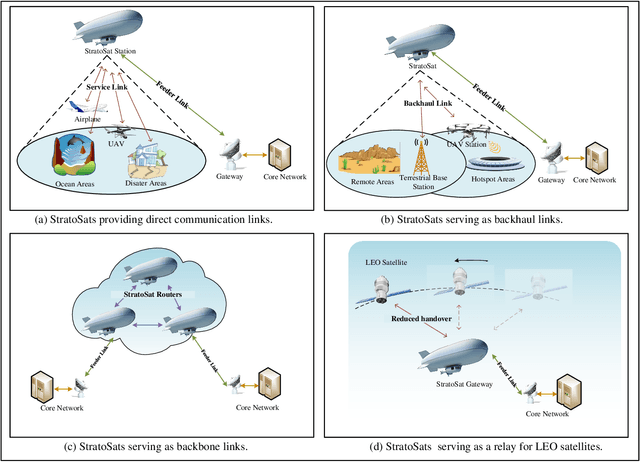
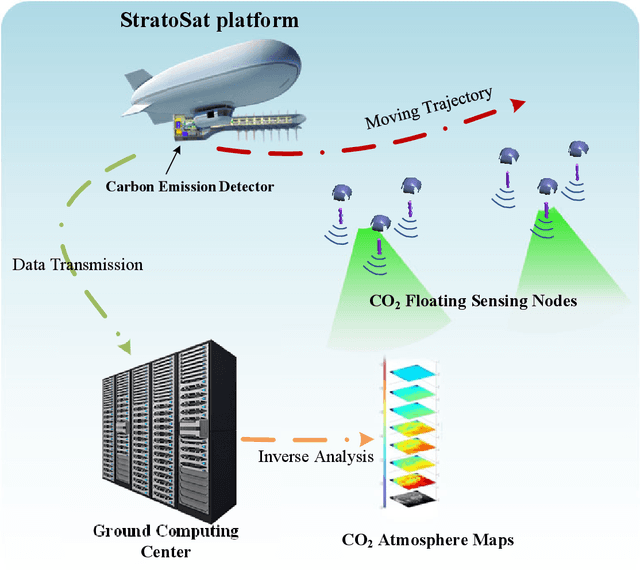
Abstract:This article presents a comprehensive study on the emerging near-space communications (NS-COM) within the context of space-air-ground-sea integrated network (SAGSIN). Specifically, we firstly explore the recent technical developments of NS-COM, followed by the discussions about motivations behind integrating NS-COM into SAGSIN. To further demonstrate the necessity of NS-COM, a comparative analysis between the NS-COM network and other counterparts in SAGSIN is conducted, covering aspects of deployment, coverage and channel characteristics. Afterwards, the technical aspects of NS-COM, including channel modeling, random access, channel estimation, array-based beam management and joint network optimization, are examined in detail. Furthermore, we explore the potential applications of NS-COM, such as structural expansion in SAGSIN communications, remote and urgent communications, weather monitoring and carbon neutrality. Finally, some promising research avenues are identified, including near-space-ground direct links, reconfigurable multiple input multiple output (MIMO) array, federated learning assisted NS-COM, maritime communication and free space optical (FSO) communication. Overall, this paper highlights that the NS-COM plays an indispensable role in the SAGSIN puzzle, providing substantial performance and coverage enhancement to the traditional SAGSIN architecture.
AFDM-SCMA: A Promising Waveform for Massive Connectivity over High Mobility Channels
Dec 18, 2023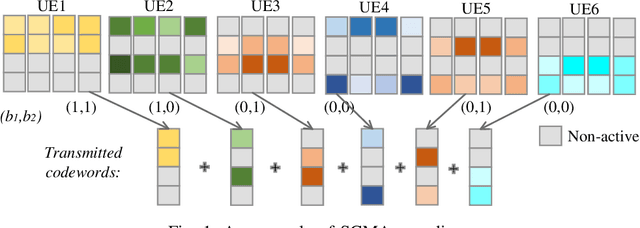
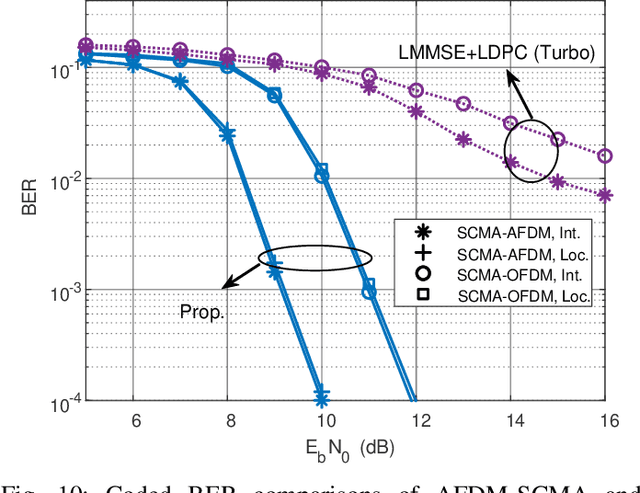

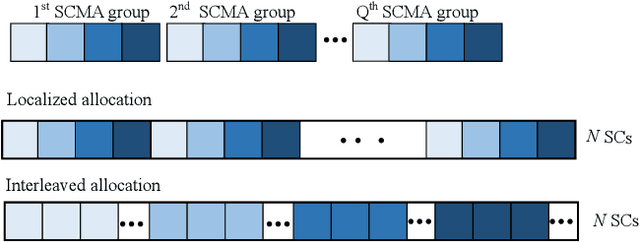
Abstract:This paper studies the affine frequency division multiplexing (AFDM)-empowered sparse code multiple access (SCMA) system, referred to as AFDM-SCMA, for supporting massive connectivity in high-mobility environments. First, by placing the sparse codewords on the AFDM chirp subcarriers, the input-output (I/O) relation of AFDM-SCMA systems is presented. Next, we delve into the generalized receiver design, chirp rate selection, and error rate performance of the proposed AFDM-SCMA. The proposed AFDM-SCMA is shown to provide a general framework and subsume the existing OFDM-SCMA as a special case. Third, for efficient transceiver design, we further propose a class of sparse codebooks for simplifying the I/O relation, referred to as I/O relation-inspired codebook design in this paper. Building upon these codebooks, we propose a novel iterative detection and decoding scheme with linear minimum mean square error (LMMSE) estimator for both downlink and uplink channels based on orthogonal approximate message passing principles. Our numerical results demonstrate the superiority of the proposed AFDM-SCMA systems over OFDM-SCMA systems in terms of the error rate performance. We show that the proposed receiver can significantly enhance the error rate performance while reducing the detection complexity.
The Road to Industry 4.0 and Beyond: A Communications-, Information-, and Operation Technology Collaboration Perspective
May 10, 2022



Abstract:The fourth industrial revolution, i.e., Industry 4.0, is evolving all around the globe. In this article, we introduce the landscape of Industry 4.0 and beyond empowered by the seamless collaboration of communication technology (CT), information technology (IT), and operation technology (OT), i.e., CIOT collaboration. Specifically, CIOT collaboration is regarded as a main improvement of Industry 4.0 compared to the previous industrial revolutions. We commence by reviewing the previous three industrial revolutions and we argue that the key feature of Industry 4.0 is the CIOT collaboration. More particularly, CT domain supports ubiquitous connectivity of the industrial elements and further bridges the physical world and the cyber world, which is a pivotal prerequisite. Then, we present the potential impacts of CIOT collaboration on typical industrial use cases with the objective of creating a more intelligent and human-friendly industry. Furthermore, the technical challenges of paving the way for the CIOT collaboration with an emphasis on the CT domain are discussed. Finally, we shed light on a roadmap for Industry 4.0 and beyond. The salient steps to be taken in the future CIOT collaboration are highlighted, which may be expected to expedite the paradigm shift towards the next industrial revolution.
Integrated Sensing and Communication with mmWave Massive MIMO: A Compressed Sampling Perspective
Jan 15, 2022



Abstract:Integrated sensing and communication (ISAC) has opened up numerous game-changing opportunities for realizing future wireless systems. In this paper, we propose an ISAC processing framework relying on millimeter-wave (mmWave) massive multiple-input multiple-output (MIMO) systems. Specifically, we provide a compressed sampling (CS) perspective to facilitate ISAC processing, which can not only recover the large-scale channel state information or/and radar imaging information, but also significantly reduce pilot overhead. First, an energy-efficient widely spaced array (WSA) architecture is tailored for the radar receiver, which enhances the angular resolution of radar sensing at the cost of angular ambiguity. Then, we propose an ISAC frame structure for time-variant ISAC systems considering different timescales. The pilot waveforms are judiciously designed by taking into account both CS theories and hardware constraints. Next, we design the dedicated dictionary for WSA that serves as a building block for formulating the ISAC processing as sparse signal recovery problems. The orthogonal matching pursuit with support refinement (OMP-SR) algorithm is proposed to effectively solve the problems in the existence of the angular ambiguity. We also provide a framework for estimating and compensating the Doppler frequencies during payload data transmission to guarantee communication performances. Simulation results demonstrate the good performances of both communications and radar sensing under the proposed ISAC framework.
 Add to Chrome
Add to Chrome Add to Firefox
Add to Firefox Add to Edge
Add to Edge